Understanding What Makes Containers Truly Biodegradable
Consumers are increasingly looking for environmentally friendly options. Biodegradable food containers are often seen as a great solution. However, not all “biodegradable” containers are the same. Understanding the science behind these materials is key to making informed decisions.
Biodegradable vs. Compostable vs. Recyclable
It’s important to differentiate between these key terms. Biodegradable means a material can be broken down by microorganisms. This can take different amounts of time and may need specific conditions. Compostable materials are biodegradable, designed to break down into compost in a controlled environment. Recyclable materials can be processed and reused to make new products. This distinction is important because a biodegradable container may not be right for home composting or your local recycling program.
The Science of Decomposition
Decomposition depends on the material and environment. Some materials, like PLA (polylactic acid) from cornstarch, need industrial composting with high heat and humidity. Others, like some bamboo-based containers, may be okay for backyard composting. It’s like different food scraps: some decompose quickly in a compost bin, while others need more specialized processing. The use of plant-based extracts and sustainable bioplastics is growing, offering safer options with less chemical migration into food.
Identifying Truly Biodegradable Containers
How can you tell if a container is truly biodegradable? Look for certifications and labels from trusted organizations like the Biodegradable Products Institute (BPI), which certifies compostable products meeting specific standards. These certifications assure the container will break down under the right conditions. Be aware of “greenwashing,” where companies exaggerate environmental benefits. Carefully check labels and information.
Performance and Trade-offs
Biodegradable containers offer environmental advantages, but there can be trade-offs. Some may not be as durable or resistant to heat and liquids as conventional plastics. A PLA container might not be suitable for hot soup or greasy food. However, advancements are constantly improving performance. Finding the right container depends on food type, storage needs, and disposal methods.
Real-World Considerations
Consider the practical aspects. Even compostable containers need composting facilities. If these aren’t available, the benefits are reduced. The cost can also be higher than conventional options. But rising demand and technology are lowering prices. Understanding these considerations is essential for making informed choices about biodegradable food containers and maximizing their positive environmental impact.
Why Smart Businesses Are Making The Switch Now
The move toward biodegradable food containers signifies a major shift in business operations. It’s more than just a passing trend; it’s a response to several key factors beyond consumer demand. Understanding these factors is essential for businesses looking to stay competitive.
Regulatory Pressures and Incentives
Governments globally are tightening regulations on single-use plastics. Many are offering incentives like tax breaks and grants to encourage businesses to adopt sustainable alternatives like biodegradable food containers. Bans on certain plastics are also creating new market opportunities for these eco-friendly options.
Cost Savings: Beyond The Initial Price Tag
Biodegradable containers may have a higher initial cost. However, many businesses are finding long-term savings. These can include lower waste disposal fees and the positive impact on brand image, attracting environmentally conscious customers. This makes the upfront investment a wise long-term financial decision.
Competitive Advantage and Brand Loyalty
Today’s consumers are increasingly eco-aware. They actively support businesses that share their values. This creates a powerful opportunity for businesses that adopt sustainable packaging. Switching to biodegradable containers can boost brand image and cultivate stronger customer loyalty, ultimately leading to increased sales and a stronger market position.
Market Dynamics and Industry Adoption
The market for eco-friendly food packaging, including biodegradable containers, was estimated between USD 199.99 billion and USD 232.9 billion in 2024. Projections show significant growth, reaching between USD 392.37 billion and USD 585.0 billion by 2034. Certain industries, like food service and quick-service restaurants, are adopting these solutions at a particularly rapid pace. This signals that biodegradable containers are quickly becoming the industry standard in some sectors.
The Cost of Waiting
Businesses that delay the switch to biodegradable containers risk significant consequences. As consumer demand and regulations evolve, businesses that fail to adapt may face declining sales, penalties, and damage to their brand reputation. This highlights the importance of proactively embracing sustainable practices. Early adoption also allows businesses to position themselves as sustainability leaders, gaining a competitive edge.
Case Studies: Success Stories In Sustainability
Many businesses have already successfully transitioned to biodegradable food containers, offering valuable lessons on the process. For instance, one small cafe experienced a significant increase in customer traffic after highlighting its use of biodegradable packaging. A large catering company reduced its waste disposal costs by implementing a composting program. These examples demonstrate the real-world benefits of sustainable packaging solutions.
Choosing Materials That Actually Work For Your Needs
Not all biodegradable food containers are created equal. Picking the wrong material can result in performance problems and higher costs than expected. This section helps you navigate the available options and select the best container for your particular needs.
Exploring Biodegradable Material Options
The world of biodegradable food containers is surprisingly diverse. From familiar cornstarch-based products to innovative materials like bamboo fiber, there’s a wide range of choices. Each material has unique properties that make it suitable for specific uses.
- PLA (Polylactic Acid): A common choice derived from cornstarch, PLA works best for cold or room-temperature foods. It composts well in industrial facilities.
- Bagasse: Made from sugarcane pulp, bagasse is strong and compostable. It’s a great option for both hot and cold foods, making it ideal for takeout containers and plates.
- Bamboo Fiber: Known for its strength and quick renewability, bamboo creates durable and attractive containers. It’s often combined with other biodegradable materials for enhanced performance.
- Mushroom Packaging: This innovative approach uses agricultural waste and mycelium (mushroom roots) to create compostable packaging, often used for cushioning and insulation.
Matching Materials to Food and Operations
Choosing the right container involves more than just the material itself. You also need to think about what kind of food you’re packaging and your operational needs.
- Hot Foods: For hot items, consider materials like bagasse or bamboo blends. These can handle higher temperatures without melting or warping.
- Cold Storage: PLA works well for cold storage because it maintains its structure and prevents leaks.
- Liquids: Containers for liquids need a tight seal and a material that won’t break down from moisture. Bagasse and PLA-coated containers are good choices.
- Extended Shelf Life: Some biodegradable materials offer better protection against oxygen and moisture, which helps certain foods stay fresh longer.
Material Performance: Real-World Testing
Real-world testing provides critical information on how biodegradable containers perform. Data and user feedback offer insights into factors like temperature tolerance, durability, and overall effectiveness.
This infographic highlights the environmental benefits of biodegradable containers. It compares their decomposition time to plastic (6 months versus 500 years), showing a significant reduction in landfill waste. The data also reveals a 70% landfill waste reduction and a savings of 1,200 tons of CO₂ emissions annually. These statistics demonstrate the substantial positive environmental impact of using biodegradable food containers.
To further illustrate the various materials’ performance attributes and suitability for different uses, let’s examine the following table:
Biodegradable Container Materials Performance Guide
| Material Type | Temperature Range | Durability Score | Cost Factor | Best Applications |
|---|---|---|---|---|
| PLA (Polylactic Acid) | Cold to Room Temperature (up to 40°C/104°F) | Medium | Low | Cold beverages, salads, dry snacks |
| Bagasse | Hot and Cold (up to 90°C/194°F) | High | Medium | Hot meals, soups, takeout containers |
| Bamboo Fiber | Hot and Cold (up to 100°C/212°F) | High | Medium-High | Durable tableware, reusable containers |
| Mushroom Packaging | Room Temperature | Low | High | Protective packaging, insulation |
This table summarizes the key characteristics of each material, helping you make informed decisions based on your specific needs. For instance, while bamboo fiber boasts high durability, it comes at a higher cost. Conversely, PLA offers a cost-effective solution for cold applications but has temperature limitations.
Making Informed Decisions
By carefully evaluating material properties, food types, and operational requirements, you can select biodegradable containers that truly fit your needs. This approach not only ensures optimal performance but also reduces waste and supports sustainability.
Real Environmental Impact Beyond The Marketing Claims
Biodegradable food containers are often presented as a sustainable choice. But looking beyond the marketing requires a deeper understanding of their real impact on the environment. This involves investigating the entire journey of these containers, from the initial sourcing of raw materials to their final disposal.
Lifecycle Analysis: A Holistic Perspective
A comprehensive evaluation means looking at every single stage. This lifecycle analysis includes the resources used in production, the manufacturing processes, the distances covered during transportation, and finally, how the containers are managed at the end of their life. Each of these steps plays a part in the overall environmental footprint. For example, the carbon emissions from transporting both raw materials and finished products can be substantial.
Comparing Biodegradable Containers to Alternatives
How do biodegradable containers compare to established alternatives like plastic or polystyrene? While biodegradable containers decompose, they often need specific conditions to break down completely, such as those found in industrial composting facilities. Traditional plastics remain in landfills for centuries. However, they’re often highly recyclable, although actual recycling rates fluctuate significantly. This comparison highlights that both options present environmental compromises.
Composting Realities: Misconceptions and Best Practices
A common misconception is that all biodegradable containers can be composted at home. This simply isn’t always the case. Some biodegradable materials require high heat and a controlled environment of an industrial composting facility. If these specific containers end up in a landfill, they lose the primary benefit of biodegradability. Understanding proper disposal is key to maximizing their positive environmental impact.
Decomposition Timeframes: Setting Realistic Expectations
The word “biodegradable” doesn’t specify a particular timeframe for decomposition. Some materials might break down in a few months under ideal conditions, while others take considerably longer. Factors such as temperature, moisture, and the presence of microorganisms also affect decomposition rates. It’s comparable to how an apple core decomposes faster than a tree branch in a compost bin. This emphasizes the need for clear labeling and consumer education regarding correct disposal methods.
The growth of the eco-friendly food packaging market highlights this change in both consumer preferences and business operations. The market’s compound annual growth rate (CAGR) is expected to be about 6.97% between 2025 and 2034.
Maximizing Environmental Benefits: Practical Guidance
To truly minimize environmental impact, choosing biodegradable food containers requires a comprehensive approach. This involves several key steps:
- Choosing certified compostable containers when access to industrial composting is available.
- Educating consumers about proper disposal methods.
- Supporting the development of composting infrastructure.
- Considering the complete lifecycle impact of the selected containers.
Making informed choices and advocating for better waste management systems will help ensure that biodegradable food containers contribute to a truly more sustainable future.
Smart Cost Management and Budget Planning Strategies
Switching to biodegradable food containers often raises concerns about cost. However, a well-planned transition can minimize the financial impact and even reveal surprising long-term savings. A careful cost analysis is crucial for informed decision-making.
Understanding the True Cost of Packaging
Cost considerations extend beyond the initial price of the containers. Traditional packaging often involves hidden costs like disposal fees, environmental cleanup expenses, and potential damage to brand reputation due to unsustainable practices. As landfill space decreases and regulations tighten, businesses may face escalating waste disposal costs.
Analyzing Pricing Data for Biodegradable Containers
The price of biodegradable food containers varies based on the material, volume, and market conditions. PLA containers are generally cheaper than bamboo or bagasse options. Bulk purchasing, however, can significantly reduce the per-unit cost, similar to how restaurants save by buying ingredients in bulk. Understanding these pricing dynamics enables smart purchasing decisions.
Cost-Reduction Strategies: Timing, Suppliers, and Operations
Several strategies can ease the transition to biodegradable containers:
- Strategic Timing: Switching during slower periods minimizes operational disruption and allows time for staff training and customer communication.
- Supplier Negotiations: Collaborating with suppliers and exploring long-term contracts can secure better pricing and a reliable supply of quality containers.
- Operational Adjustments: Simple changes, such as using smaller containers for certain items or encouraging reusable bags, can reduce consumption and lower overall costs.
Building a Compelling Business Case
Switching to biodegradable containers necessitates a strong business case, demonstrating a clear return on investment (ROI). While the initial investment might seem higher, long-term savings from reduced waste disposal, increased customer loyalty, and a stronger brand image can offset upfront expenses.
Budgeting Frameworks and ROI Calculations
Practical budgeting tools are essential for planning and tracking expenses. A simple spreadsheet can track costs for different container types, volume discounts, and operational adjustments. ROI calculations can project long-term financial benefits, including reduced waste disposal and increased sales from a positive brand image.
To help visualize a complete cost comparison between traditional and biodegradable options, let’s examine the following table. It provides a detailed cost breakdown, including purchase price, operational impact, compliance costs, and long-term value comparison.
Total Cost Analysis: Biodegradable Vs Traditional Options
| Container Category | Initial Cost | Volume Pricing | Hidden Costs | Long-term Value |
|---|---|---|---|---|
| Traditional Plastic | Low | Moderate discounts | High disposal fees, potential brand damage | Low due to environmental concerns |
| Biodegradable (PLA) | Medium | Significant discounts with bulk orders | Lower disposal costs, positive brand image | High due to sustainability |
| Biodegradable (Bagasse) | Medium-High | Moderate discounts | Lower disposal costs, positive brand image | High due to durability and sustainability |
This table highlights the significant long-term value of biodegradable options. While traditional plastic might have a lower initial cost, the accumulating hidden and long-term costs often outweigh this initial advantage. Biodegradable options offer substantial long-term value thanks to their reduced environmental impact and the boost they can give to your brand’s reputation.
Long-Term Savings Opportunities
Transitioning to biodegradable containers unlocks significant long-term savings. Reduced waste disposal fees, lower environmental cleanup costs, and increased operational efficiency all contribute to substantial savings over time. A stronger brand image and increased customer loyalty can also drive higher sales and revenue.
By carefully evaluating all cost aspects, businesses can make informed decisions about switching to biodegradable food containers, setting themselves up for long-term financial success and environmental responsibility.
Implementation Roadmap That Actually Works
Switching to biodegradable food containers is a big step towards a more sustainable business. But making the change successfully needs a well-thought-out plan. This roadmap offers practical guidance, drawing on proven strategies from businesses that have already made a smooth transition.
Planning Your Transition Timeline
A realistic timeline is key. Begin by evaluating your current packaging stock and how quickly you use it. This helps figure out a reasonable timeframe for phasing out your existing containers and bringing in the biodegradable options. A small cafe might switch over in a few weeks, while a larger restaurant chain might need several months. Rolling out the change gradually, perhaps by product line or location, can also make the process easier.
Staff Training and Buy-In
Your staff are essential to a successful switch. Provide clear training on the new containers: what they’re made of, how to handle them, and how to dispose of them properly. Explain why you’re making the change to gain their support and enthusiasm. Highlighting the environmental benefits and the positive impact on customer perception can help.
Communicating With Your Customers
Be upfront with your customers. Clearly explain why you’re moving to biodegradable containers, focusing on the environmental advantages. Use in-store signs or website updates to educate customers about the new containers and how to dispose of them. This builds understanding and support for your sustainability efforts.
Evaluating and Vetting Suppliers
Choosing the right suppliers is crucial. Think about material quality, certifications, pricing, and reliable delivery. Request samples and test them thoroughly to make sure the containers meet your needs. For instance, try them with hot and cold foods to check they can handle different temperatures.
Ensuring Consistent Quality Standards
Keeping a consistent quality is vital for happy customers. Set up clear quality control checks for incoming biodegradable container shipments. Regularly inspect them for defects. Get feedback from both staff and customers to spot any potential problems and address them quickly.
Managing Inventory During the Transition
Careful inventory management helps avoid running out of containers and reduces waste during the changeover. Estimate how many biodegradable containers you’ll need based on your sales forecasts. Set up a system to track inventory levels and reorder supplies efficiently. Consider offering discounts on any remaining traditional packaging to minimize waste.
Biodegradable food containers are gaining popularity thanks to their positive environmental impact. They offer numerous benefits, such as less landfill waste and reduced chemical migration into food compared to traditional plastics. This shift reflects a growing consumer demand for safer, more sustainable choices.
Compliance and Certification
Understanding regulations and certifications is important. Research your local rules on biodegradable food packaging. Check for certifications from trusted organizations like the Biodegradable Products Institute (BPI) to confirm your containers meet industry standards. This demonstrates compliance and builds customer trust.
Marketing Your Sustainability Commitment
Promote your switch to biodegradable containers. Highlight your commitment to sustainability on your website, social media, and in-store. Share your story with customers and emphasize the positive impact of supporting your business. This boosts your brand image and attracts environmentally conscious customers.
By following this roadmap and putting these strategies into action, your business can smoothly transition to biodegradable food containers, minimizing any disruption and maximizing the positive impact for both your business and the planet.
Key Takeaways For Sustainable Packaging Success
Transitioning to biodegradable food containers offers significant advantages for both the environment and your business. However, successful implementation requires careful planning and execution. This section distills key takeaways from industry best practices and real-world examples to guide you on your journey towards sustainable packaging.
Defining Your Sustainability Goals
Start by clearly defining your objectives. Are you aiming to reduce landfill waste, enhance your brand image, or both? Specific goals help you measure progress and demonstrate the value of your sustainability initiatives.
For instance, you might set a target to reduce packaging waste by 20% within the next year. This provides a concrete benchmark for evaluating your success.
Material Selection: Finding The Right Fit
Choosing the appropriate biodegradable material is crucial. Consider factors like temperature requirements, durability needs, and the types of food you’ll be packaging.
PLA might be suitable for cold items, while bagasse is a better choice for hot foods. Much like choosing the right tool for the job, careful selection ensures optimal performance and minimizes issues.
Understanding Disposal and Composting
Not all biodegradable containers decompose in the same way. Some require industrial composting facilities, while others can break down in home compost bins.
Educate your staff and customers about proper disposal methods to maximize the environmental benefits. Clear labeling and informative signage are essential.
Cost Management and Long-Term Savings
While biodegradable containers may have a higher initial cost, they can lead to long-term savings. Reduced waste disposal fees, increased customer loyalty, and a positive brand image can outweigh the upfront investment.
Additionally, the global market for eco-friendly food packaging, which includes biodegradable containers, has experienced significant growth. In 2020, the market size was estimated at USD 174.7 billion, and projections indicate it will reach USD 249.5 billion by 2025. This growth is driven by increasing environmental awareness and stricter regulations targeting single-use plastics.
Building Internal Buy-In and Customer Enthusiasm
Engage your staff and customers in your sustainability journey. Explain the reasons behind the switch to biodegradable containers and highlight the positive impact.
This fosters support and creates a shared sense of responsibility. Sharing success stories of other businesses can be a powerful motivator.
Supplier Evaluation and Partnership
Choosing reliable suppliers is essential for consistent quality and dependable delivery. Vet potential suppliers carefully, considering their certifications, material sourcing practices, and customer service.
A strong supplier partnership ensures a smooth transition and ongoing support, much like choosing a trusted business partner.
Implementation Checklist: A Practical Guide
- Assess Current Needs: Evaluate your existing packaging usage.
- Set Realistic Goals: Define specific, measurable, achievable, relevant, and time-bound (SMART) targets.
- Choose the Right Materials: Select biodegradable materials that meet your needs.
- Develop a Transition Plan: Outline a clear timeline for introducing new containers.
- Train Your Staff: Educate your team on handling and disposal procedures.
- Educate Your Customers: Inform your customers about the benefits and proper disposal.
- Monitor and Evaluate: Track your progress and adjust your strategy as needed.
Troubleshooting Common Challenges
- Cost Concerns: Explore bulk purchasing and long-term contracts.
- Performance Issues: Carefully test different materials to ensure they meet your requirements.
- Customer Resistance: Clearly communicate the environmental benefits and address concerns proactively.
By following these key takeaways and the implementation checklist, you can effectively transition to biodegradable containers, reducing your environmental footprint and enhancing your brand image.
Ready to make the switch to sustainable packaging? Explore MrTakeOutBags.com‘s wide selection of biodegradable food containers and other eco-friendly packaging solutions today!

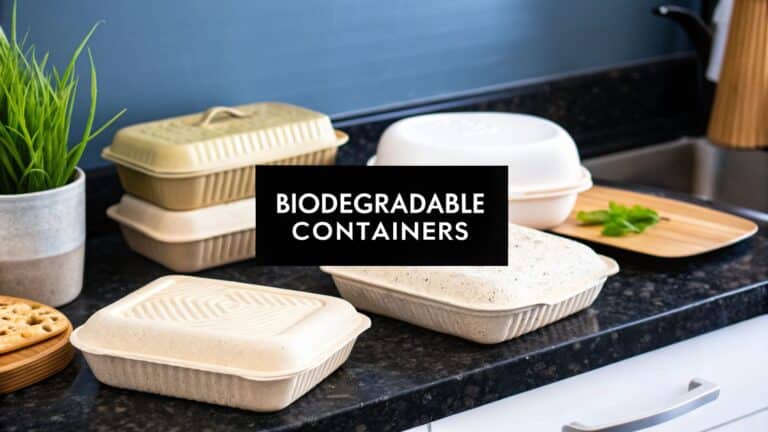
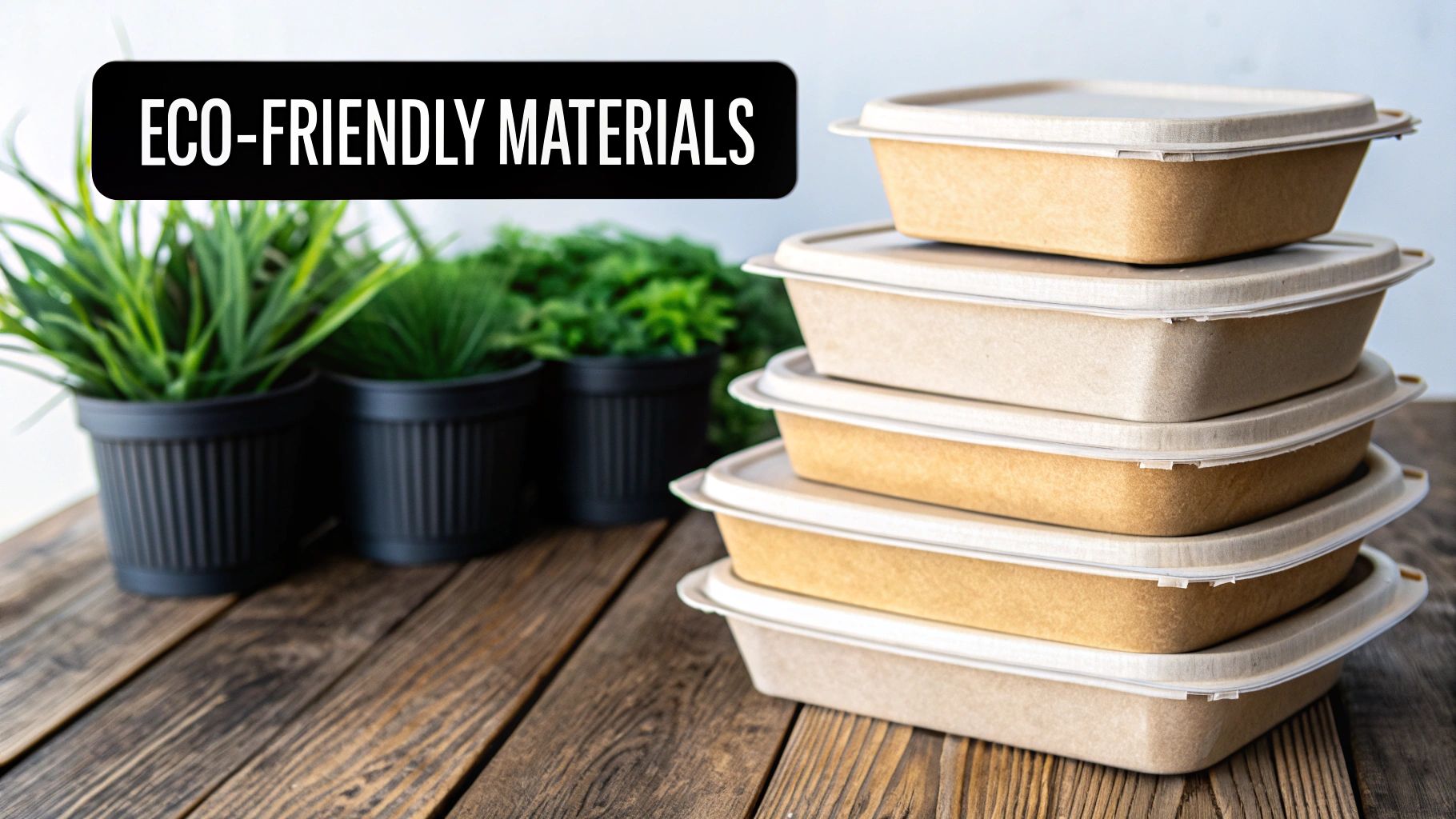
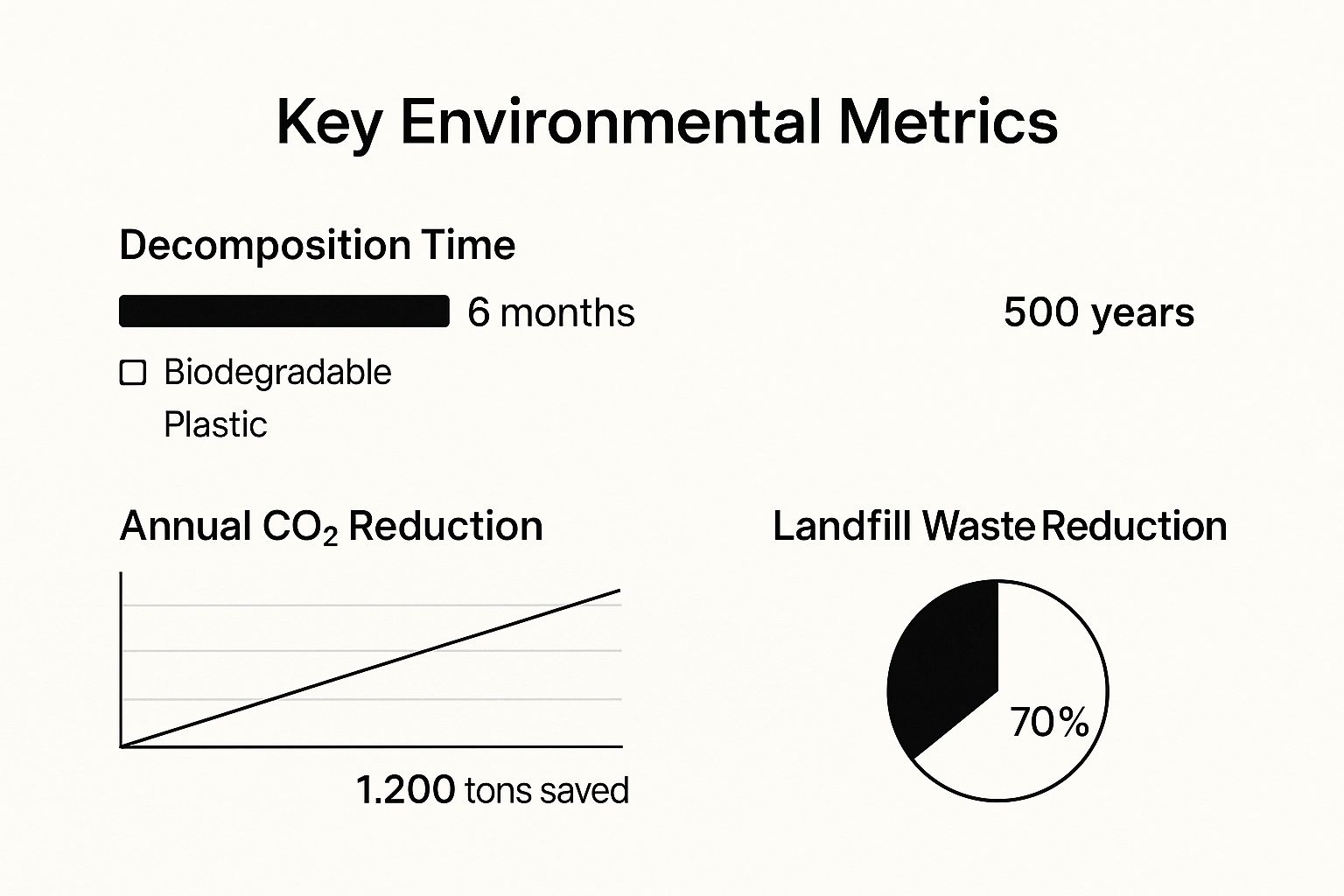
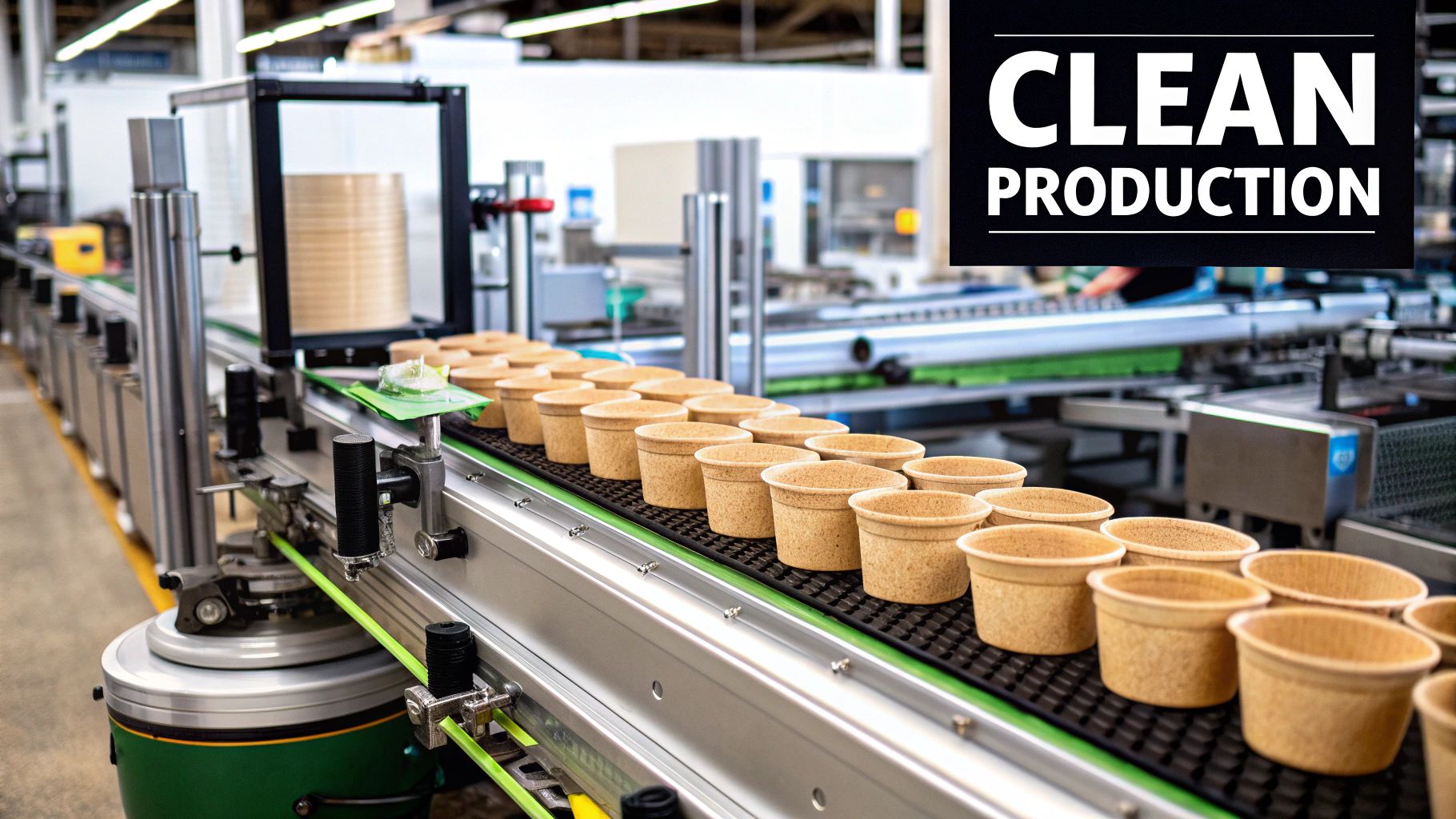
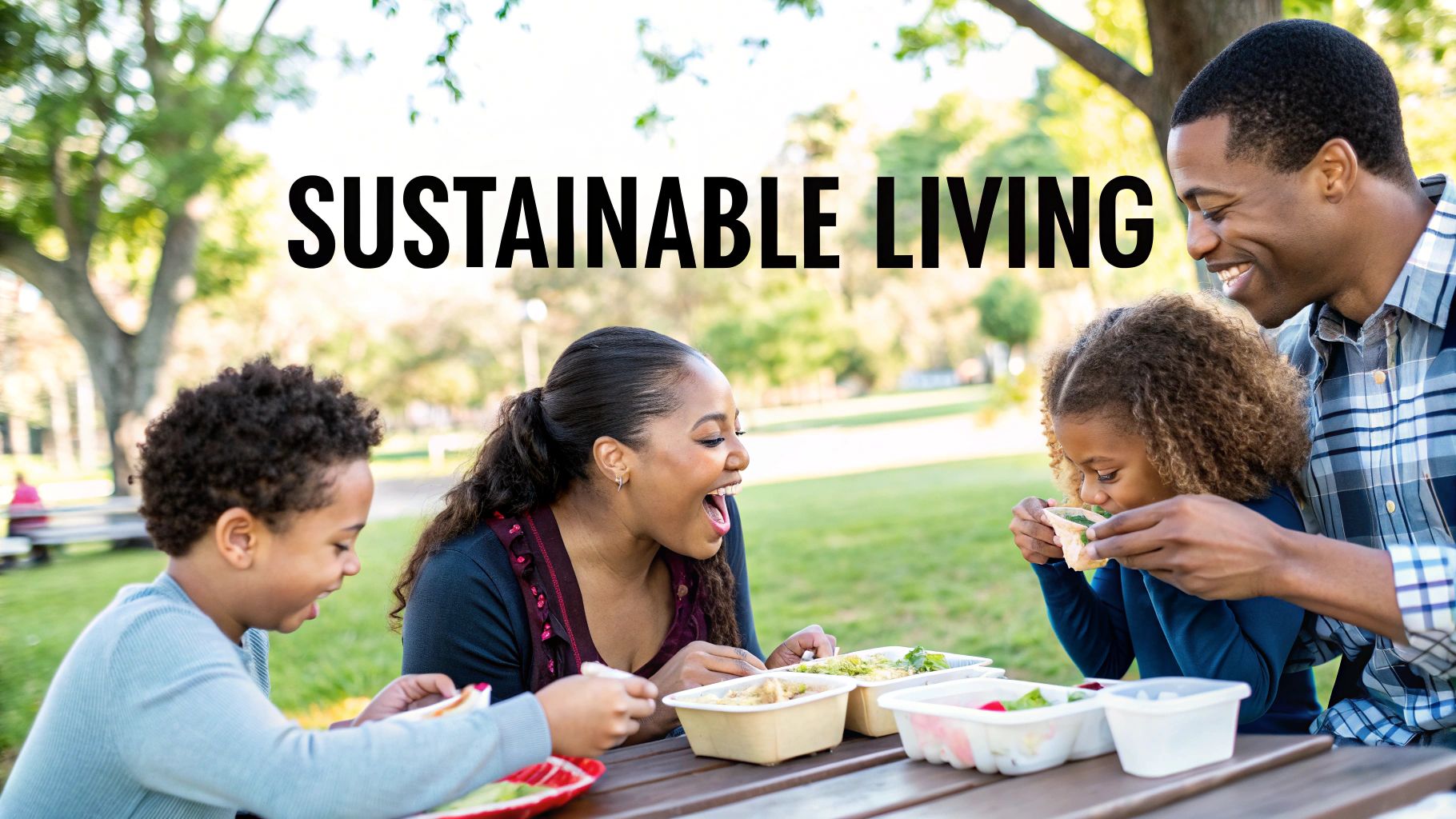
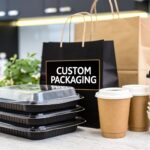

Comments are closed.